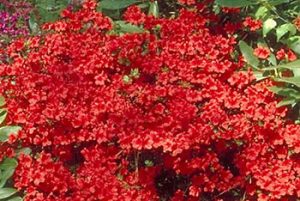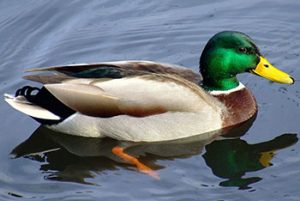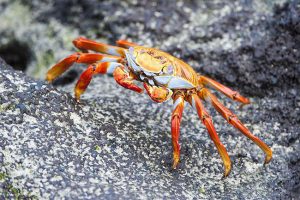Habitat & Wildlife on the Poudre River Corridor
 Riparian Habitat
Riparian Habitat
The Cache la Poudre River has remained in a semi-natural state even though much of the land around it has been developed for agriculture, housing, retail or industrial purposes. Because the river experiences periodic flooding and the high-water table that exists as a result, it makes the land undesirable for development and protected as wetlands in some areas. As a result the river has given the wildlife a refuge from human intervention.
However, there has been a great deal of gravel pit mining along the river. Active gravel mining is visible as one travels along the trail. The gravel is used for roads and concrete. After the gravel pit has been abandoned, the ground water fills it in turning the pit into a pond. The cattails, grasses, shrubbery and trees then establish themselves around this new water source.
The plant growth also helps to slow down the current giving the sediment a chance to settle out. This means that the moving water is then cleaner as it flows downstream. The plant growth also helps slow erosion along the banks of the river. The river, the ponds and the vegetation form what is called a riparian habitat which is very important to the overall environment.
The river and the ponds also make a good place for fish, insects and amphibians to live and breed. This area is a great place for birds and mammals as they feast on the seeds and berries as well as the fish, insects and amphibians. The trees, grasses, cattails and shrubbery give the birds places to nest, and provide protection from hot days and from predators.

Aerial view of the Poudre River in Weld County, illustrating a “meandering” river. Source: mapquest.com
Local Topography
At this stage of the river where it flows across the prairie, the Cache la Poudre River is called a “meandering” river. This is characterized by the many turns that the river makes, the oxbow lakes and the ancient river bluffs. If you look at the river from an aerial perspective, it looks rather “snake-like”.
These features reflect how the river has changed its course over the centuries. Before the advent of the dams and all of the other demands on the rivers resources, the Poudre River carried much more water. It frequently flooded with the Spring snowmelt and Summer rains. The flooding river would wear away certain areas and then deposit gravel and sand from the floodwaters somewhere else. The oxbow lakes are what remains of the old river bed. The bluffs are what remains of the ancient topography after the river has cut deeper into its valley.
 There are a variety of plants along the Poudre River
There are a variety of plants along the Poudre River
Floodplain Grasslands
Grassland habitats provide food for many species of birds and animals. The dry Northern
Grassland
 Riparian Cottonwood Forests
Riparian Cottonwood Forests
The forests that you walk through along the Poudre River are made up of cottonwoods, varieties of willows, boxelder, alders, and elm trees.
These are natural trees to a
 Open Water Riverine
Open Water Riverine
This is the area of moving water in the form of the Poudre River and creeks and streams that feed into it. It also encompasses the shoreline and banks along the river. The Poudre River is a meandering stream with tight curves and oxbox lakes. It is the habitat for fish, plants and insects. Grasses, rushes, sedges and cattails as well as shrubs and trees grow along its banks.
 Open Water Ponds and Lakes
Open Water Ponds and Lakes
The oxbow ponds are natural to a river like the Poudre River. They form as the river changes its course during flood events. The oxbow lakes represent the previous river bed. They provide a still water environment for fish and the plants that live in and out of the water. They also make an excellent place for water fowl to be protected from predators.
As the ponds fill in with silt and rocks, they become shallower and more likely to turn green with algae growth during hot summer days. These ponds will eventually fill in and become marshy areas full of reeds and cattails. The gravel mining that has taken place along the river over the last century creates large pits which become ponds.
 Shrubs
Shrubs
In addition to the Cottonwood Forests and the Grasslands, there are many varieties of shrubs along the trail. You can see sage brush and scrub oak and shrubs that produce berries. The shrubbery is very important for small birds to find protection and for mammals and birds for food. As with the other plants, the shrubbery is important for flood mitigation and to help prevent soil erosion.
The most common mammals that live along the Poudre River are squirrel, rabbit, skunk, mice, opossum, raccoon, porcupine, prairie dogs, beaver, vole, fox, bat, coyote and deer. You will also come across domestic farms animals such as cows, horses and maybe a llama or two.
Moose, elk, bear and mountain lion have been spotted along the river corridor on rare occasions. Information about “Living with Wildlife” can be found on the Colorado Parks & Wildlife website https://cpw.state.co.us/learn/Pages/LivingwithWildlife.aspx
 Deer are more active at daybreak and at sunset. The male deer will have antlers, the more points on the antlers means the older the deer. The young spotted fawns are around in the Spring. Be sure to stay quiet around the deer, they are skittish and will bounce away if they know that you are around.
Deer are more active at daybreak and at sunset. The male deer will have antlers, the more points on the antlers means the older the deer. The young spotted fawns are around in the Spring. Be sure to stay quiet around the deer, they are skittish and will bounce away if they know that you are around.
 Raccoons and bats are nocturnal and skunks are active around dawn or dusk. The best time to see many of the mammals along the trail is early morning. You will most likely come across squirrels and rabbits, as they are busy all day.
Raccoons and bats are nocturnal and skunks are active around dawn or dusk. The best time to see many of the mammals along the trail is early morning. You will most likely come across squirrels and rabbits, as they are busy all day.
Prairie dog colonies are present along sections of the trail. Prairie dogs burrow under the ground and eat roots, grasses, weeds, and other available plant life. While some people view them as a nuisance, they are an important species to the prairie ecosystem, providing food for raptors and other predators.
 The Poudre Trail offers many opportunities for bird watching. The cottonwood forests, the cattail marshes, the ponds and the Poudre River itself, all attract a wide variety of water fowl, predatory birds and song birds. Weld County has over 300 species of birds, and this corridor of green is an excellent haven for them. You may or may not see the birds you are looking for, but if you are quiet and listen, you may hear them.
The Poudre Trail offers many opportunities for bird watching. The cottonwood forests, the cattail marshes, the ponds and the Poudre River itself, all attract a wide variety of water fowl, predatory birds and song birds. Weld County has over 300 species of birds, and this corridor of green is an excellent haven for them. You may or may not see the birds you are looking for, but if you are quiet and listen, you may hear them.
 Water Birds of the Ponds and Marshes
Water Birds of the Ponds and Marshes
Many varieties of ducks make this their home for at least part of the year. Among the more common varieties are Wood Ducks and Mallards. Canadian Geese occupy these ponds by the hundreds as they settle in for the winter. The skies fill will their distinctive “V” shape flocks come November through March and some will stay year round. You may also see Swans, American White Pelicans, Loons, Grebes, Cormorants, Herons, Ibises, Rails, Cranes, Avocets, Sandpipers, Gulls, and Terns.
 Predatory Birds and Scavengers
Predatory Birds and Scavengers
The grasslands, the marshes, the river and the ponds are home to mice, squirrels, frogs, fish and prairie dogs. These all provide food for the predatory birds and the scavengers. Along the trail you may see a variety of Hawks, Turkey Vultures, Falcons, Owls, Bald Eagles and Golden Eagles.
These birds may be up in the high branches of the Cottonwoods and Willows or perched on a utility pole, observing the world below them for their food. Watch as they swoop down for the kill or glide in graceful circles above your head.
Song Birds and other Smaller Varieties
Numerous species of songbirds and other small birds either make the river corridor their permanent home or visit here on their migratory journeys.The most common varieties are Sparrows, Robins, Finches, Flycatchers, Hummingbirds, Swallows, Chickadees, Nuthatches, Meadowlarks, Creepers, Wrens, Kinglets, Thrushes, Warblers, the list goes on.
 Ground Dwelling Birds
Ground Dwelling Birds
There are many spots on the trail that you may come across wild turkeys, quail and grouse. The Wild Turkeys are omnivores, which means they will eat insects, seeds, or fish. These birds will group together in large bands and you may hear them before you see them.
 Other Bird Species
Other Bird Species
You will likely come across Redwing Blackbirds, Crows, Starlings, Magpies, Jays and Woodpeckers. These are all very common larger birds for this area.
 The Poudre River has many fish that need to live in flowing waters. There are also many ponds along the river that are open for fishing. The fish feed on the algae and plants, the tadpoles and the insect larvae that are in the water. The fish in turn are food for the eagles, the pelicans, and other water fowl.
The Poudre River has many fish that need to live in flowing waters. There are also many ponds along the river that are open for fishing. The fish feed on the algae and plants, the tadpoles and the insect larvae that are in the water. The fish in turn are food for the eagles, the pelicans, and other water fowl.
Some of the varieties of fish are: Bluefin, Catfish, carp, shiners, minnows, largemouth bass.
Reptiles, Amphibians and Crustaceans
Crawdads, turtles, frogs, toads, salamanders, bull snakes, lizards,
Snakes
There are multiple species of snakes in Eastern Colorado. They live along the riparian habitat of the Poudre River Trail because of the abundance of small mammals for a food source. Some snakes are large, such as the Bull Snakes and the Rattlesnakes, but some are small and harmless, such as garter snakes. Some snakes even swim in the water.
Snakes are a very important part of keeping an ecosystem in the balance as they keep the rodent population in check. Bull snakes are common along the Poudre Trail. Don’t be fooled, they look very similar to Rattlesnakes and even mimic their rattle, but they are not poisonous. Chances are that you won’t come across one, but you should always be on the lookout for snakes, especially on warm sunny days when they are more active. Stay away from all snakes, and let them be. They are important to the ecosystem.
Frogs, Toads and Salamanders
If you walk down the trail in the evening in late Summer, you will likely hear a chorus of frogs. Frogs lay their eggs in still water ponds, the eggs hatch into tadpoles, then tadpoles with legs, then froglets with tails, then mature into frogs. There are many species of frogs and toads in this section of Colorado,
Turtles
You may see one or two turtles sunning themselves on a log in the water. In Weld
Some turtles, such as the Painted Turtle, can live in the water or on land. Wild painted turtles prefer slow-moving shallow waters or ponds and marshes with soft, muddy bottoms. They forage on plants during the day, bask in the sun, and sleep underwater.
Crustaceans
Crawdads occasionally come out of the water and can be seen on the Poudre River Trail in areas where the trail travels close to the river. Crawdads have a difficult time tolerating polluted water, so if you see one that means good things for the health of the river!
Insects
Insects are a very important part of an overall ecosystem. They are food sources for birds and mammals, they help to break down decomposing foliage as well as animal carcasses and animal waste and they help to pollinate flowers.
The Poudre River Corridor, being a riparian habitat, is an excellent place to see a variety of insects. As you travel down the trail you are likely to see dragonflies, butterflies, moths, bees, gnats, mosquitoes, beetles, grasshoppers, and ants.
Dragonflies
Dragonflies are a beautiful and beneficial insect. They are valuable predators that feed on mosquitoes and other small insects like flies, wasps
Dragonflies have an elongated body with two pairs of wide colorful transparent wings. There are many varieties of dragonflies. You may also come across “damselflies” and the way to tell them apart is that when still, dragonflies hold their wings open, perpendicular to their body, while damselflies hold their wings tight up against themselves.
Butterflies
In the Summer
If you are traveling down the trail in October, you will likely see furry little caterpillars crossing the trail.
Mosquitoes
Because of all of the open ponds and still water areas of the Poudre River, you will encounter many mosquitos in the Spring and Summer. They are most active at
Grasshoppers
If you are making your way down the trail in late Summer or early Autumn, there will be areas where you see hundreds of grasshoppers. They are harmless to humans, but a very important source of food for certain birds.
CONNECT WITH THE TRAIL
